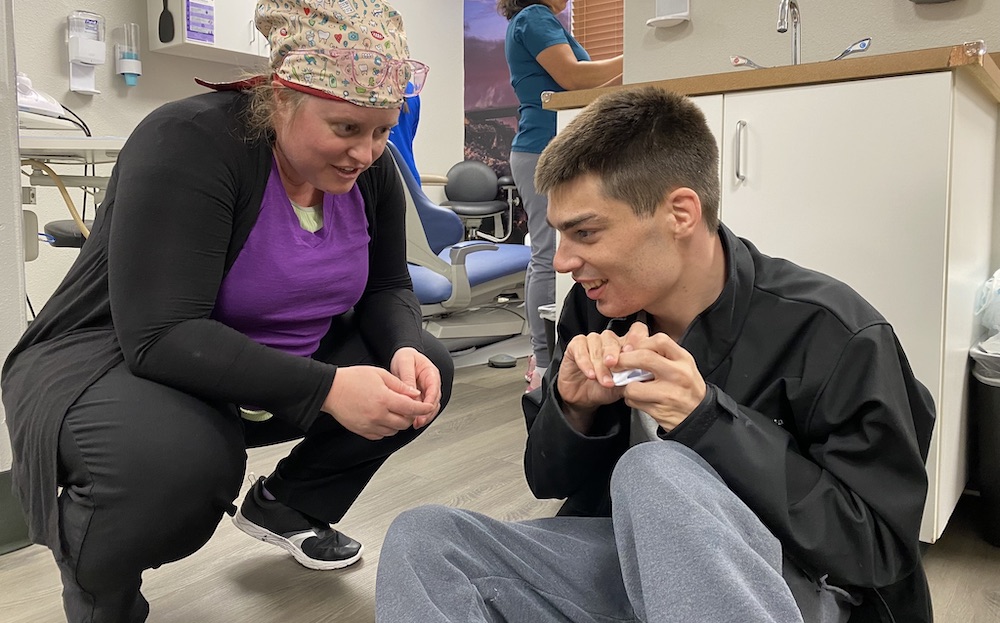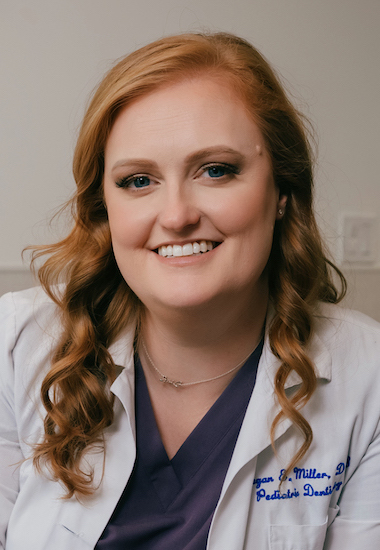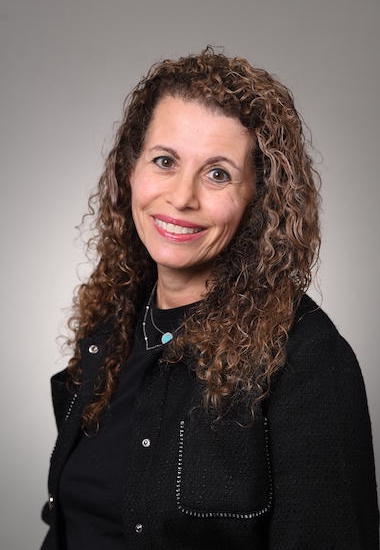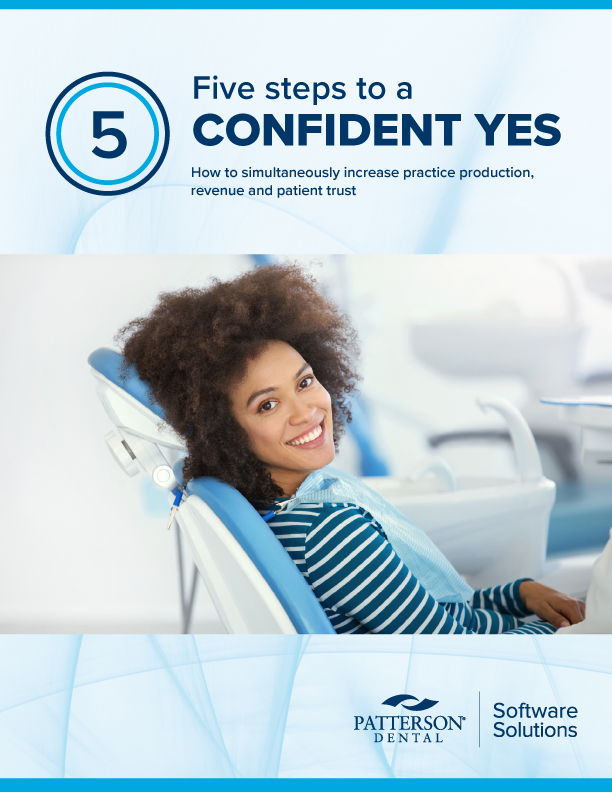What to know about treating different types of patients
Some patients may require additional supports, considerations from their dentists





Dentists treat a wide variety of patients in their practices, each with their own oral health care needs and goals for dental treatment.
Some patients may require additional supports and considerations from their dentists and dental teams.
Below is advice from four dentists on treating groups of patients dentists may encounter in their practices. Find additional resources at ADAStore.org.
People with disabilities
“When considering people with disabilities, it’s important to recognize that abilities exist on a spectrum — what poses a challenge for one person may not be an issue for another,” said Brooke Fukuoka, D.M.D., owner of Your Special Smiles, a mobile dental practice in Idaho that specializes in providing dental care to adults with disabilities and seniors with limited mobility living in group homes and long-term care facilities. She is also a dentist at Family Health Services’ Advanced Delivery Dental Clinic, a federally qualified health center clinic in Jerome, Idaho, that offers dental services to adults with disabilities, including hospital-based services.
People with disabilities may have difficulty performing daily oral hygiene tasks effectively because of various barriers. These can include the taste or texture of toothpaste being overwhelming for those with sensory sensitivities; those with cognitive disabilities perhaps having difficulty understanding the importance of oral hygiene or forgetting to do it; and physical limitations, such as severe tremors, making tasks like flossing nearly impossible, Dr. Fukuoka said.
When explaining treatments or oral hygiene best practices, dentists should speak directly to the patient first — even if they believe the patient may not fully understand — as they are the most important person in the conversation, she said.
If the patient is not the one making decisions or carrying out daily care, then dentists should also speak with the person who is responsible for those tasks. If the decision-maker or care provider cannot be present, providing clear written instructions and following up with a phone call when possible can help ensure important details are passed on, Dr. Fukuoka said.
There are also steps dentists can take to help make their practices more comfortable for people with disabilities.
For example, patients in wheelchairs may not be able to transfer to a dental chair without specialized equipment or trained personnel present. In these cases, Dr. Fukuoka treats patients while they remain in their wheelchairs by adjusting her own position, using a wheelchair lift that can tilt patients back as if they were in a dental chair, or using settings on adjustable wheelchairs to raise, lower and recline patients.
Dentists can have those with sensitivities to light wear sunglasses or cover their eyes with something like a towel if the operatory does not have dimmable lights, she said. Avoiding playing music, turning on multiple TVs and running ticking clocks can help patients with sound sensitivities. Having headphones available to patients or allowing them to bring their own to cancel out noise or listen to something they enjoy can also help.
People with disabilities may have difficulty reclining to receive dental treatment, which can be related to physical or physiological reasons. Dr. Fukuoka said it’s important to understand the reason to help guide the appropriate accommodations.
For example, if patients have difficulty swallowing saliva, reclining can make breathing harder, so using suction can help, but avoiding reclining these patients may be safest to avoid aspiration, she said. Reclining may also cause pain in patients with back issues, limit airflow in patients with obesity hypoventilation syndrome and trigger acid reflux discomfort in patients with GERD.
Patients could also have a history of trauma or a fear of the unknown, which can make reclining feel vulnerable, unsafe or intimidating until trust is built.
“If a patient cannot lean back due to a physiological need, forcing the position will be unsuccessful for both patient and provider. In such cases, treatment should be done in a more upright posture,” Dr. Fukuoka said. “Progress may be possible after establishing your clinic as a safe space and building trust with the patient and their caregivers. In those cases, take small, comfortable steps toward reclining, and celebrate each success.”
Above all, Dr. Fukuoka has the following advice: Always see the person first.
“The real key to success is simple: View patients with disabilities as people with unique abilities and genuinely seek to connect with them,” she said. “They have the same wants, needs and desires as anyone else. When we treat them the way we would want to be treated, success follows. Small, kind gestures often make the biggest difference.”
Seniors
Dental conditions associated with aging include dry mouth, root and coronal caries, and periodontitis, according to the American Dental Association’s Oral Health Topics webpage on aging and dental health.
The baseline health of seniors can vary significantly based on conditions such as high blood pressure and diabetes. Seniors may regularly use several prescription and over-the-counter medications, making them more vulnerable to medication errors, drug interactions and adverse drug reactions, according to the Oral Health Topics page. They may also show increased sensitivity to drugs used in dentistry, including local anesthetics and analgesics.
Through Your Special Smiles’ portable dentistry, Dr. Fukuoka treats seniors living in group homes and long-term care facilities. Poor oral hygiene is a common problem among seniors, as they may have difficulty performing these daily tasks on their own because of cognitive or physical issues associated with aging, she said. Dr. Fukuoka has developed a toolkit to help other dental practices launch portable oral hygiene programs to assist seniors at yourspecialsmiles.com.
These cognitive and physical issues associated with aging can also make patient education and communication challenging, according to the Oral Health Topics page. Dr. Fukuoka said it’s important to explain treatments and oral hygiene best practices first to seniors and then to their caregivers if applicable. Additional recommendations shared on the webpage for communicating during appointments include: minimizing distractions and noise in the operatory; making introductions, smiling and maintaining eye contact; and using simple instructions.
Regarding physical limitations, Dr. Fukuoka’s previous advice for treating wheelchair users — adjusting the dentist’s position, using a wheelchair lift or using a wheelchair’s adjustable settings — applies to seniors too. Seniors may also have difficulty reclining because of back pain, swallowing difficulties or other issues. If they require a thickener when drinking liquids, Dr. Fukuoka said she rarely reclines them.
For patients with hearing loss, the ADA Practical Guide to Patients with Medical Conditions recommends speaking clearly and naturally while facing the patient, minimizing background noise when speaking, and using written and illustrated materials to help explain procedures and instructions. The Oral Health Topics page also shares recommendations for treating patients with visual loss, such as having large-print magazines available in the waiting room and installing good lighting throughout the office.
Teens without parents present
At Expedition Pediatric Dentistry in Bellevue, Washington, owner Megan Miller, D.D.S., requires a guardian to be present for appointments with new patients. However, for subsequent visits, if the patients are teens who can drive themselves and the practice has received written authorization from their guardians, the teens can attend appointments alone.
Dr. Miller still encourages parents to accompany their children to appointments, as having them present when reviewing medical histories, explaining examination findings and presenting treatment plans can result in fewer misunderstandings and clearer expectations for parents and staff, she said.
“Parents may choose to remain in the waiting area, but most children and parents prefer to remain together,” Dr. Miller said. “As children develop more independence, agency and comfort with dental visits, the percentage who request to come back unaccompanied increase.”
When determining the best policy for her practice regarding guardians being present during appointments, Dr. Miller reviewed recommendations from the American Academy of Pediatrics and legal requirements for her state and researched the legal ramifications and risks of permitting unaccompanied minors to receive treatment without a parent present.
The specifics regarding treatment consent vary among states and depend on the circumstances, so health care providers need to check their state’s particular laws, she said.
“Incomplete medical histories and true informed consent are the two most pressing concerns when permitting minors to receive any treatment without a parent present,” Dr. Miller said. “Even with electronic forms and the possibility that a parent could complete a medical history in advance, an opportunity to ask questions about positive answers on a health history is an essential step for all new patients. Similarly, while we are able to email parents the proposed treatment plan, that may not constitute informed consent. Informed consent laws vary from state to state but may require review of risks, benefits and alternatives with the opportunity to ask questions.”
Following appointments with teens whose parents are not present that result in no planned treatment, Dr. Miller will send a written report to their guardians via a HIPAA-compliant email and encourage them to reach out with any questions or concerns. If treatment is planned, she will email the treatment plan to guardians and schedule a call to discuss findings and treatment options and obtain informed consent.

Anxious or skeptical parents
When treating pediatric patients, dentists may encounter anxious or skeptical parents.
With anxious parents, Dr. Miller may ask them to step out of their child’s line of sight — if she thinks the child would benefit from that — while continuing to watch the appointment.
“I may even mention that it has been shown that when parents are anxious, it may increase a child’s anxiety and that calming techniques, like breath work, could be beneficial for both parent and child,” she said. “If a parent’s anxiety manifests by them interfering with communication between our team and the child, then I will remind them that they have agreed to our behavior management guidelines, which ask them to be a silent observer. I also find myself saying that their child needs to know whose direction to follow, and if our team and parents are giving conflicting information, a child will not know which authority figure to listen to and will typically default to parent.”
If parents disagree with treatment recommendations for their child, the most important step dentists can take is to first establish they both want the same thing: for their child to be healthy and comfortable physically and psychologically, Dr. Miller said.
“After you’ve made sure to demonstrate that you are on the same team, then you can approach their disagreement with curiosity and dig into what they are actually concerned about,” she said. “Most disagreements regarding treatment come from fear, anxiety, misunderstanding. Once you identify the root cause, you can find paths through and around their concerns.”
One area where parents may be skeptical because of growing misinformation is fluoride.
“Similar to disagreements on treatment plans, you want to establish right out of the gate that you are concerned about safety,” Dr. Miller said. “There are many ways to do this, but my favorite is to ask parents about all of their child's fluoride sources and remind them that we are trying to get just the right amount. If you start by showing parents you are concerned about safety, they will be much more likely to accept your fluoride recommendations.”
That said, dentists could encounter extreme anti-fluoride parents. Dr. Miller’s goal with those families is to use the psychological phenomenon of social proof, or the idea that if other people like them are doing something, it is the right or desirable thing to do.
“I ask if I can share with them what has worked for other fluoride-minimizing families that are in our practice,” she said. “There’s research to show that just asking if you can share and having them agree to hear what you have to share increases their desire to agree with you.”
If their children presently do not have caries, Dr. Miller tells the parents she will note they are minimizing fluoride and will continue with that plan, but if she starts to see caries forming, they can revisit that decision.
“Often, these families are open to introducing minimal amounts of fluoride if we do see the start of a cavity,” she said. “If they already have cavities, then I recommend they introduce the lowest dose of fluoride, which is mouth rinse. Then, once you are in the in-group of fluoride-minimizing families, we can make a lot of progress toward fluoride acceptance and caries reduction.”
Nervous patients
Ann Blue, D.D.S., who owns Blue Periodontics and Implants in Scottsdale, Arizona, is a nervous dental patient herself because of pain she felt as a child during dental procedures — giving her empathy for the nervous patients she encounters in her own practice. As a periodontist, she anticipates that many patients are nervous for their first visit, as the practice is new to them and they are worried about the oral health problem they are having.
“We know it is natural to be nervous and are ready for these patients,” she said. “We try to alleviate the nervousness prior to our first visit with our new patient letter that introduces them to us and is a positive letter affirming that they are proceeding in the right direction. We maintain as much positivity as possible during their first visit and continuing visits with us.”
Besides trying to create a positive and affirming environment, Dr. Blue and her team also attempt to identify patients’ fears and validate rather than discount them. If the fears are addressable, then they attempt to address them, with an emphasis on communicating.
“If they are worried about the pain during a procedure, I communicate how I do the procedure and then promise them that they will be numb during the procedure or I will not proceed with the procedure,” she said. “I relate my experiences as a child and help them realize that I do identify with them and their concerns are valid and real.”
When it’s time for the procedure, Dr. Blue and her team make sure the operatory is welcoming, calming and comfortable and then continue to provide positive reinforcement by encouraging patients during the procedure and thanking them afterwards.
When treating nervous patients, she recommends dentists train their dental team to be empathetic; acknowledge and normalize patients’ fears; not rush appointments, especially for new patients and first procedures; build extra time into appointments if patients need that time to manage their anxiety; assign a team member who has good rapport with a patient to help them remain calm during the appointment; and follow up with patients after their appointments to demonstrate they are important to you.
“By following some of these suggestions, your nervous patients can actually become your raving fans and make their treatment procedures more comfortable for you and your team as well,” Dr. Blue said.
Pregnant patients
Preventive, diagnostic and restorative dental treatment, including radiographs and local anesthesia, is safe throughout pregnancy, according to both the ADA and the American College of Obstetricians and Gynecologists.
The organizations also agree that emergency dental treatments, such as extractions, root canals and restorations, can safely be performed during pregnancy and that delaying treatment may result in more complex problems.
Multiple oral health conditions are more common during pregnancy. These include gingivitis, which may result from hormonal changes that make the gums more sensitive to plaque bacteria; caries, which may occur for a number of reasons, including changes in diet, increased oral acidity caused by vomiting, dry mouth, or poor oral hygiene stemming from nausea and vomiting; pyogenic granulomas, which are round growths connected to the gums that may develop because of hormonal changes and may go away after the baby is born; and erosion caused by vomiting, according to the ADA’s Oral Health Topics webpage on pregnancy.
Research has shown associations exist between maternal periodontitis and pre-term birth, babies with a low birth weight, babies with a low birth weight who are born prematurely, and the development of preeclampsia, although findings have been mixed and more research is needed, according to the Oral Health Topics page.
Still, both the ADA and the American College of Obstetricians and Gynecologists recognize scaling and root planing as safe to perform if periodontitis develops during pregnancy.
When talking to pregnant patients about the safety and importance of receiving dental care during pregnancy, Elizabeth Simpson, D.M.D., adjunct faculty at the Indiana University School of Dentistry and former chair of the ADA Council on Advocacy for Access and Prevention, first says dental professionals need to get on the same page based on current guidance from the ADA.
“I was in a situation a while back where I heard another provider asking for a medical consult for a pregnant patient before they could do periodontal charting. As long as patients are getting conflicting messages from the people who should have the most up-to-date information that is scientifically backed and who they should be able to trust, then we are going to continue to have patients who one, don’t see the dentist when they are pregnant, and two, are complaining about the effects of their babies on their teeth after they give birth,” she said.
Dr. Simpson recommends dentists put pamphlets or other information in their offices about dental treatment and oral health care during pregnancy. They can also post about it on social media and encourage their pregnant family and friends to go to the dentist.
“We have to communicate to our patients with a consistent message that it’s safe for them to be seen during pregnancy,” she said.



